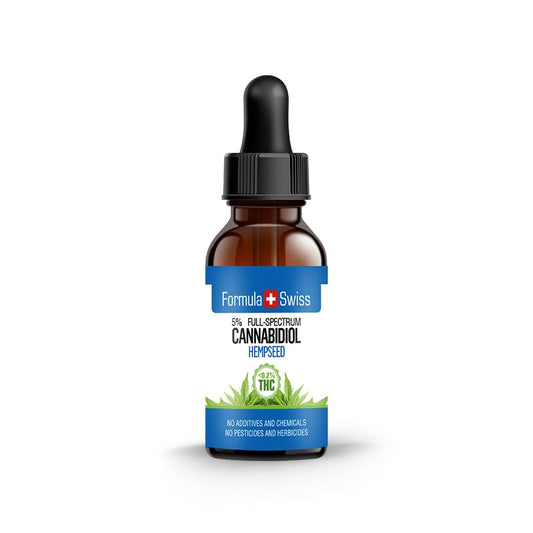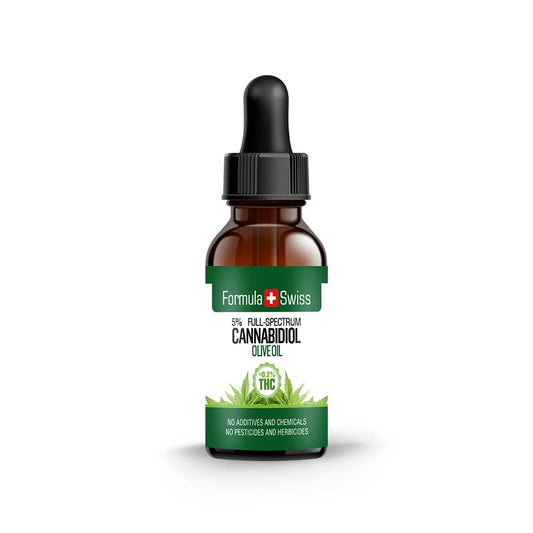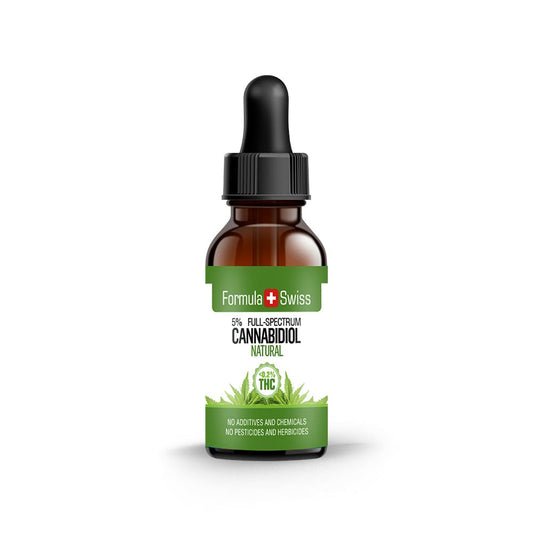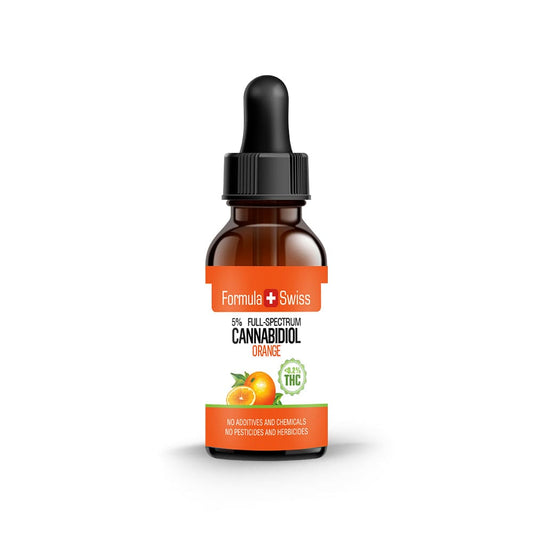Most people familiar with cannabis can name CBD or THC—but few realise that other compounds play essential roles in how those cannabinoids come to exist. One of those lesser-known components is cannabichromenic acid, or CBCA.
In my work with Formula Swiss for over a decade, I’ve focused on understanding the plant beyond the surface-level compounds. CBCA might not be widely recognised, but it plays a direct role in the development of CBC (cannabichromene), another non-psychoactive cannabinoid of increasing interest.
CBCA is an acidic cannabinoid found in raw cannabis. Through decarboxylation—a heat-driven process—it converts into CBC, a transformation that reflects how the chemistry of the plant shifts depending on how it's handled. This step is more than a technicality; it’s a key part of the plant’s natural progression.
As more attention is given to the full cannabinoid spectrum, CBCA is beginning to receive the recognition it deserves. It’s not just a precursor—it’s a foundational part of the plant’s chemical profile, and one that professionals and researchers are now studying more closely.
Prefer watching over reading? This video covers the key points from the article:
Save up to 30% when you order your CBD oil today
Key takeaways
- CBCA is naturally found in the Cannabis sativa L. plant, particularly in its early growth stages.
- Being an acidic cannabinoid, CBCA is non-psychoactive and holds potential for medicinal use.
- The compound serves as a precursor to CBC, changing form through the decarboxylation process.
- Advances in microbial synthesis highlight the potential for increased CBCA production.
- A deeper understanding of CBCA's role within cannabinoids is crucial for future therapeutic applications.
This article is provided for informational purposes only and does not relate to any of the products available in our webshop. For more information, please see our full disclaimer.
Introduction to CBCA (Cannabichromenic acid)
Cannabichromenic acid, known as CBCA, is a naturally occurring compound found within the cannabis plant. While it has often been overshadowed by more widely recognised cannabinoids, CBCA is gradually attracting more interest for its unique properties. Unlike certain other compounds derived from cannabis, CBCA does not produce any intoxicating effects.
Preliminary research has examined how cannabichromenic acid (CBCA) interacts with biological systems, focusing on its characteristics in relation to microbial environments and plant-derived compound behaviour. These early studies offer insights that may contribute to the future development of cannabinoid-based formulations.
Further studies have also examined how CBCA may enhance the overall effectiveness of cannabinoid blends, especially in contexts where non-intoxicating options are preferred. This growing body of research underscores the importance of continuing to investigate CBCA in greater depth.
A study published in Antibiotics investigated the antibacterial properties of various cannabinoids, including CBCA, against methicillin-resistant Staphylococcus aureus (MRSA). The research found that CBCA, when combined with silver nanoparticles, exhibited enhanced antibacterial activity, suggesting a synergistic interaction that could be valuable in developing new antimicrobial therapies.
Understanding how CBCA works can be very useful. I'm committed to studying CBCA more. This will help us see its full potential in medicine.
Order CBD oil now and save as much as 30%
Understanding the origins of CBCA in cannabis plants
Morimoto et al. (1998) demonstrated that CBCA (cannabichromenic acid) is a key biosynthetic compound in Cannabis sativa L., serving as the direct precursor to cannabichromene (CBC). As a journalist, I've looked into CBCA's history. It's mainly found in young Cannabis plants. CBCA is part of the plant's bioactive compounds, along with other important cannabinoids.
CBCA is special because it undergoes decarboxylation into cannabichromene (CBC) upon heating. This change is not just chemical. It shows how the plant's compounds work differently.
Gaining insight into the origins of cannabichromenic acid (CBCA) helps clarify its role within Cannabis sativa L. This deeper understanding continues to inspire researchers and cultivators, who are working to develop cannabis varieties with tailored phytochemical profiles.
The story of CBCA's origins and changes highlights the complex world of cannabinoids. As research finds more uses for these compounds, knowing where they come from is key.
Chemical structure and properties of CBCA
Cannabichromenic acid (CBCA) is a naturally present cannabinoid acid found in cannabis plants, acting as the acidic precursor to cannabichromene (CBC). It has the chemical formula C22H30O4 and a molecular weight of 358.47 g/mol.
While its molecular structure shares the core characteristics typical of cannabinoids, it features unique functional groups that influence its interactions within biological systems.

CBCA possesses distinct characteristics that differentiate it from other cannabinoids. Its unique molecular structure has sparked considerable interest among researchers, who are keen to explore its potential applications.
Ongoing studies aim to deepen the understanding of CBCA and investigate how it might be utilised in various scientific and industrial contexts.
| Cannabinoid | Chemical structure | Notable properties |
|---|---|---|
| CBCA | C21H30O4 | High affinity to CB2 receptors |
| THCA | C22H30O4 | Precursor to THC, non-psychoactive in its raw form |
| CBDA | C22H30O4 | Precursor to CBD |
Knowing about CBCA's structure and properties opens up new possibilities. It helps us understand its potential uses. This knowledge is key for future research and medical applications.
Extraction and isolation techniques for CBCA
Getting CBCA right is key for quality. New tech and methods help us get it pure. This is thanks to the hard work of researchers and industry experts.
Chiral liquid chromatography and high-resolution mass spectrometry are top-notch for CBCA. They handle CBCA's tricky properties well. This combo lets us study CBCA in detail, showing its unique traits in Cannabis sativa L. varieties.

Isolating CBCA is all about careful steps. These steps keep CBCA pure for use in research and other fields.
Here's a look at some isolation methods I know well. They show how well each method works for CBCA:
| Technique | Resolution | Suitability for CBCA |
|---|---|---|
| Chiral liquid chromatography | High | Very suitable |
| Ultra-performance liquid chromatography | Moderate | Suitable |
| Gas chromatography | Low | Less suitable |
| Supercritical CO2 extraction | Not Applicable | Moderately suitable |
Each method has its own strengths. The right choice affects both the amount and quality of CBCA. This is vital for research and other uses.
Significance of CBCA among other cannabinoids
In my study of plant compounds, I've found CBCA (cannabichromenic acid) to be vital but often ignored. CBCA research shows how lesser-known cannabinoids can boost the healing power of cannabis. This is a key area of study.
CBCA is often overshadowed by CBD and THC. Yet, it has its own qualities that are worth noting. These qualities are especially important when considering the entourage effect. The entourage effect is a concept which proposes that the combined presence of various cannabis compounds may offer enhanced outcomes compared to isolated components.
What is the entourage effect in cannabis?
The role of CBCA in the entourage effect
Research on CBCA highlights its interaction with other cannabinoids. This synergy can enhance the benefits of cannabis extracts. Understanding these interactions is crucial for unlocking the full potential of plant compounds.
Comparing CBCA with CBD and THC
| Cannabinoid | Psychoactive properties | General interest | Research focus |
|---|---|---|---|
| CBCA | Non-psychoactive | Explored for its role within the entourage effect and studied for interactions with other plant compounds | Emerging research interest, often compared to CBD in early-stage studies |
| CBD | Non-psychoactive | Widely used in wellness products, with interest in its plant-based origins and versatility | Extensively researched, with numerous studies examining its characteristics and properties |
| THC | Psychoactive | Recognised for its prominent role in cannabis varieties and its influence on user experience | Well-documented in scientific literature, particularly regarding its psychoactive nature and plant interactions |
Non-psychoactive nature of CBCA
CBCA’s non-psychoactive nature makes it an intriguing subject for specific applications. Its potential lies in offering plant-based properties without inducing psychoactive experiences.
This characteristic has drawn attention in scientific research, where CBCA’s unique profile continues to be explored for its possible contributions within broader cannabinoid studies.
Which cannabinoids produce a psychoactive effect?
Potential areas of use for CBCA
Cannabichromenic acid (CBCA) is attracting attention for its non-psychoactive properties. Its potential applications are being explored in healthcare and biotechnology, particularly in pharmaceutical development and antimicrobial research.
Studies indicate that CBCA may display noteworthy biological activities while not influencing cognitive function, positioning it as a topic of interest in the search for innovative applications.
Research featured in Microorganisms (2025) highlights that acidic cannabinoids, including CBCA, have demonstrated activity against resistant bacterial strains like MRSA. These findings support the ongoing scientific exploration of CBCA’s potential within this context.
Interest in pharmaceutical research
Pharmaceutical research continually seeks new and well-tolerated compounds. In this pursuit, CBCA is gaining attention for its distinctive profile. Its non-psychoactive nature presents an opportunity to explore symptom management without the typical effects associated with other cannabinoids, making it an increasingly relevant focus in scientific studies.
Current research and studies on CBCA
Research into CBCA (Cannabichromenic Acid) is gaining momentum. Current studies are looking at its interactions with bacteria and its potential role in inflammation-related processes, helping to broaden scientific understanding and guide future applications.
A 2023 study by Gojani et al. examined how cannabichromene (CBC) interacts with gene expression pathways related to inflammation. The study identified a reduction in activity within the IL-6/TYK-2/STAT-3 signalling pathway as part of these interactions.
Since CBCA serves as the direct precursor to CBC, these findings provide valuable insights and raise questions about CBCA’s potential influence on similar biological processes through its conversion pathway. Continued research is necessary to explore this area further.
What is CBC (Cannabichromene)?
| Property | Scientific insight | Research direction |
|---|---|---|
| Antibacterial activity | Observed to inhibit growth of certain bacterial strains, including MRSA | Explored for potential synergy with antimicrobial strategies |
| Influence on inflammation | Examined for its potential influence on inflammation-related pathways | Further research into its relevance for immune-related conditions |
As scientific research continues, expanding knowledge of CBCA’s properties remains a key focus. While findings are preliminary, they highlight the value of ongoing investigation and the need for further studies to clarify CBCA’s potential within this field.
Challenges in CBCA research and product development
Product development involving CBCA comes with several challenges. Its extraction demands precise techniques to preserve purity and strength, and advanced analytical tools are necessary to accurately identify and measure the compound. The limited clinical data adds uncertainty, highlighting the need for more scientific studies to support its future use.
| Component | Challenge | Requirement |
|---|---|---|
| Extraction | Intricate separation processes | Highly precise technology |
| Analysis | Accurate identification and quantification | Advanced analytical instruments |
| Data availability | Lack of comprehensive clinical studies | Increased research funding and collaboration |
Dealing with these challenges shows the importance of improving analytical methods and teamwork. This will lead to significant advancements in CBCA product development. It will help create more focused and effective cannabinoid-based solutions.
Order and enjoy up to 30% off your CBD oil purchase
Future prospects and ongoing developments in CBCA research
Scientific interest in CBCA (cannabichromenic acid) continues to build as researchers examine its role in the broader landscape of cannabinoids. Current studies are focusing on its potential relevance in areas such as inflammation and microbial activity—both of which are central themes in ongoing cannabinoid research.
These investigations are laying the groundwork for deeper insights into CBCA's function and how it may contribute to future applications. As researchers work to better understand its interactions with other cannabinoids and biological systems, CBCA is being included in discussions around targeted formulation strategies.
- Areas of particular focus include:
- Broadening CBCA studies to include potential therapeutic applications
- Investigating how CBCA may be used in combination with other cannabinoids
- Clarifying its behaviour in biological environments through preclinical models
Although the body of research is still developing, the sustained interest in CBCA reflects a wider effort to move beyond the better-known cannabinoids. Continued exploration and methodical study will be essential for determining how CBCA fits into future product development and scientific inquiry.

Personal perspective
In my work with Formula Swiss, I’ve often noticed that CBCA doesn’t get the same attention as more familiar compounds like CBD or THC. But its role as the precursor to cannabichromene (CBC) highlights just how layered and intricate the plant’s chemistry really is.
Over the years, I’ve seen a growing number of researchers and professionals begin to look more closely at these so-called minor cannabinoids. CBCA stands out to me not just because of what it leads to, but because of the role it already holds within the plant’s natural structure. I genuinely believe it has a meaningful part to play in the ongoing exploration of cannabinoids and their development.
Don’t miss out—save up to 30% when you purchase CBD oil today
Frequently asked questions
What is CBCA (cannabichromenic acid)?
CBCA is a naturally occurring cannabinoid acid found in raw cannabis plants, serving as the precursor to cannabichromene (CBC). It is one of the acidic forms produced early in the plant's biosynthesis process.
How is CBCA produced in the cannabis plant?
CBCA is formed when geranyl pyrophosphate reacts with olivetolic acid to create cannabigerolic acid (CBGA), which is then converted by specific synthase enzymes into CBCA. This biosynthesis occurs in the glandular trichomes of the cannabis plant.
What is the difference between CBCA and CBC?
CBCA is the acidic precursor that converts into CBC through a process called decarboxylation, typically triggered by heat or light. CBC is the neutral, active form found after this conversion.
Is CBCA psychoactive?
CBCA is considered non-psychoactive and does not produce intoxicating effects. Unlike THC, it does not bind strongly to CB1 receptors in the brain.
What are the potential benefits or uses of CBCA?
Current research focuses on CBCA's properties in industrial and cosmetic applications. Its role in plant defence mechanisms is also of scientific interest.
How does CBCA interact with the body?
CBCA is believed to have minimal affinity for cannabinoid receptors CB1 and CB2. Its interactions are mainly studied for their influence on the endocannabinoid system and enzyme modulation.
Are there CBCA products available on the market?
CBCA-specific products are rare, with most formulations focusing on decarboxylated cannabinoids like CBC, CBD, or THC. Some raw cannabis extracts may contain trace amounts of CBCA.
How does CBCA compare to other cannabinoids like THC and CBD?
Unlike THC, CBCA is non-psychoactive and does not produce intoxicating effects. Compared to CBD, CBCA remains in its acidic form unless decarboxylated and is less commonly featured in commercial products.
What is CBGA (Cannabigerolic acid)?






